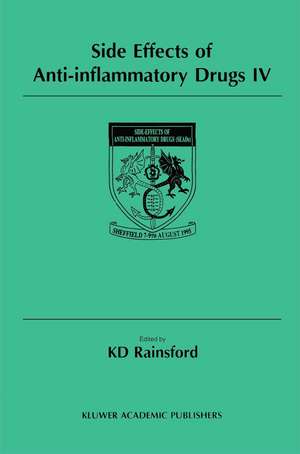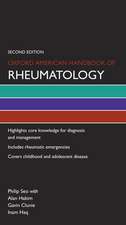Side Effects of Anti-Inflammatory Drugs IV: The Proceedings of the IVth International Meeting on Side Effects of Anti-inflammatory Drugs, held in Sheffield, UK, 7–9 August 1995
Editat de K. D. Rainsforden Limba Engleză Paperback – 5 noi 2012
In addition to discussions on the safety relative to efficacy of established non-steroidal and steroidal anti-inflammatory drugs and disease-modifying agents, there was detailed consideration of the novel cyclo-oxygenase-2 selective NSAIDs which have recently been developed and introduced to the clinic. Also, the side effects from therapy with biologics, notably monoclonal antibodies and oral tolerance therapies, were considered.
Among the other highlights in the programme were:
- Clinico-epidemiological studies on the adverse effects relative to use/efficacy of established and new anti-rheumatic drugs.
- Procedures for reducing the gastrointestinal adverse effects.
- Mechanisms and clinical significance of adverse effects in the gastrointestinal tract, liver, kidney, articular joints, skin and other organs from NSAIDs.
- Clinical status and mechanisms of action of the newer (third generation) of NSAIDs (e.g. etodolac, nabumetone, meloxicam).
- Medico-legal aspects of adverse effects from anti-rheumatic drugs.
- The concept of `conditional pharmacology' or the disease-dependence of the toxicological and pharmacological activity of the anti-inflammatory drugs.
The papers in this book were selected from those presented at the meeting.
| Toate formatele și edițiile | Preț | Express |
|---|---|---|
| Paperback (1) | 1413.93 lei 6-8 săpt. | |
| SPRINGER NETHERLANDS – 5 noi 2012 | 1413.93 lei 6-8 săpt. | |
| Hardback (1) | 1420.85 lei 6-8 săpt. | |
| SPRINGER NETHERLANDS – 30 apr 1997 | 1420.85 lei 6-8 săpt. |
Preț: 1413.93 lei
Preț vechi: 1488.34 lei
-5% Nou
Puncte Express: 2121
Preț estimativ în valută:
270.54€ • 282.50$ • 223.41£
270.54€ • 282.50$ • 223.41£
Carte tipărită la comandă
Livrare economică 15-29 aprilie
Preluare comenzi: 021 569.72.76
Specificații
ISBN-13: 9789401062695
ISBN-10: 9401062692
Pagini: 372
Ilustrații: XII, 356 p.
Dimensiuni: 155 x 235 x 20 mm
Greutate: 0.52 kg
Ediția:Softcover reprint of the original 1st ed. 1997
Editura: SPRINGER NETHERLANDS
Colecția Springer
Locul publicării:Dordrecht, Netherlands
ISBN-10: 9401062692
Pagini: 372
Ilustrații: XII, 356 p.
Dimensiuni: 155 x 235 x 20 mm
Greutate: 0.52 kg
Ediția:Softcover reprint of the original 1st ed. 1997
Editura: SPRINGER NETHERLANDS
Colecția Springer
Locul publicării:Dordrecht, Netherlands
Public țintă
ResearchCuprins
I. Introduction.- Current status of side-effects from anti-inflammatory drugs.- II. Clinico-Epidemiological Aspects.- The placebo response: clinical efficacy and toxicity.- Side-effects of non-steroidal anti-inflammatory drugs: studies from the Tayside Medicines Monitoring Unit.- Treatment decisions, side-effect liability and cost-effectiveness in osteoarthritis.- Measuring beneficial and adverse events in osteoarthritis clinical trials.- Do NSAIDs adversely affect joint pathology in osteoarthritis?.- Safety of non-steroidal anti-inflammatory drugs during pregnancy and lactation.- Side-effects from biologics in the therapy of rheumatic diseases.- Oral tolerance from a general perspective, and the possible role of side-effects in the gut.- Summary of Debate: Management of side-effects from anti-inflammatory drugs.- III. Fundamental Aspects.- The concept of conditional pharmacology and toxicology.- Inflammation, stress and environmental factors as determinants of NSAID efficacy and toxicity.- Do you really know what your drug looks like or how it reacts?.- IV. Gastrointestinal Tract — Clinical Aspects.- Intestinal pathology from NSAIDs.- A clinician’s view of strategies for preventing NSAID-induced gastrointestinal ulcers.- Protection from NSAID-induced gastrointestinal damage.- An overview of the key role of misoprostol in the prophylaxis of NSAIDassociated ulcers and their complications.- Clinical update of the relative safety of nabumetone in long-term clinical trials.- Global analysis of gastrointestinal safety of a new NSAID, meloxicam.- V. Gastrointestinal Tract — Experimental.- Gastrointestinal adaptation, eicosanoids, and mucosal protection from NSAIDs.- New insight into NSAID-induced gastropathy.- Cyclooxygenase selectivity and NSAIDs: cyclooxygenase-2selectivity of etodolac (Lodine).- Differential inhibition of cyclooxygenase-1 (COX-1) and -2 (COX-2) by NSAIDs: Consequences on anti-inflammatory activity versus gastric and renal safety.- Polymer delivery of the mucosal protective prostaglandin misoprostol.- Nitric oxide-releasing NSAIDs, a novel class of safe and effective anti-inflammatory agents.- Mitochondrial function and modification of NSAID carboxyl moiety.- Effects of a new class of NO-releasing NSAIDs on platelets and isolated arteries.- A1 and A2 adenosine receptors mediate opposite effects on NSAID-induced gastric ulcers in the rat.- Role of vagal nerve in defence mechanisms against NSAIDs-induced gastrointestinal mucosal damage.- Analysis of the inhibiting activity of presynaptic a2-adrenoceptors against NSAID-induced gastric mucosal lesions in the rat.- VI. Dermatoxicity.- Mechanisms of adverse reactions in the skin from anti-rheumatic drugs.- Can in-vitro assays predict chemically-induced skin damage?.- VII. Novel Therapies.- The use of ketorolac tromethamine oral rinse for the treatment of periodontitis in adults.- VIII. Abstracts.- Variability in risk of major upper gastro-intestinal complications with individual NSAIDs. Importance of drug dose and half-life; results of meta analysis.- Non-steroidal associated ulcer bleeding — defining the risk factors.- Variability in exposure to NSAIDs in relation to safety.- Non-steroidal anti-inflammatory drugs and infertility.- Perioperative use of NSAID and postoperative infectious complications.- Medico-legal issues of non-steroidal anti-inflammatory drugs (NSAIDs).- The use of DMARDs and combination therapies.- Non-steroidal anti-inflammatory drugs and acute appendicitis: a case-control study.- Non-steroidal anti-inflammatory drugs and colitis: arecord-linkage case-control study.- New exposure to NSAIDs and hospitalisation for upper gastrointestinal events.- Topical NSAIDs and upper gastrointestinal bleeding and perforation.- Non-steroidal anti-inflammatory drugs, aspirin and colo-rectal cancer.- The pattern of prescribing of community dispensed ulcer-healing drugs in Tayside.- Clinical trials of the relative safety of nabumetone in long-term clinical trials: proposed rationale for safety profile.- Cyclooxygenase-2: a novel target for safety anti-inflammatory drugs.- Inhibitory action of hydrophilic polymers on gastric lesions induced by indomethacin in rats.- Copper-derivatives and gastroprotection.- The ?3-adrenoceptor agonist CL316243 prevents indomethacin-induced jejunal ulceration in the rat.- IX. Epilogue.- The dilemma of modern medicine.









